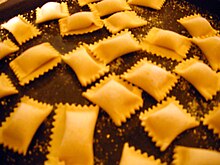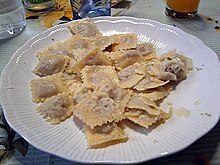Agnolotti: Difference between revisions
No edit summary Tags: Manual revert Reverted |
No edit summary Tags: Reverted Visual edit |
||
| (One intermediate revision by the same user not shown) | |||
| Line 5: | Line 5: | ||
| caption = |
| caption = |
||
| alternate_name = piat d'angelòt, agnellotti, agnolòt, langaroli, langheroli |
| alternate_name = piat d'angelòt, agnellotti, agnolòt, langaroli, langheroli |
||
| country = |
| country = |
||
| region = [[Piedmont]] |
| region = [[Piedmont]], [[Savoie]] |
||
| creator = |
| creator = |
||
| course = [[entrée|primo piatto]] |
| course = [[entrée|primo piatto]] |
||
| Line 19: | Line 19: | ||
[[File:Agnolotti_piemontesi.jpg|thumb|Typical dish of homemade ''agnolotti piemontesi alla moda di [[Asti]]''.]] |
[[File:Agnolotti_piemontesi.jpg|thumb|Typical dish of homemade ''agnolotti piemontesi alla moda di [[Asti]]''.]] |
||
'''Agnolotti''' ({{IPA-it|aɲɲoˈlɔtti|pron}}; {{lang-pms|agnolòt}} {{IPA-pms|aɲʊˈlɔt|}}) is a type of [[pasta]] typical of the [[Piedmont]] region of [[Italy]] made with small pieces of flattened [[pasta]] dough, folded over a filling of roasted meat<ref name="De Vita 2009 p. 31">{{cite book | last=De Vita | first=O.Z. | title=Encyclopedia of Pasta | publisher=University of California Press | series=California Studies in Food and Culture | year=2009 | isbn=978-0-520-94471-8 | url=https://archive.org/details/encyclopediaofpa00zani | url-access=registration | access-date=November 5, 2016 | page=[https://archive.org/details/encyclopediaofpa00zani/page/31 31]}}</ref> or vegetables. ''Agnolotti'' is the plural form of the Italian word ''agnolotto''. According to a legend, the origin of the name may come from a cook called Angiolino, or "Angelot", an individual from [[Montferrat]] who is said to be the inventor of the recipe.<ref name=":0">{{Cite book|title=Géométrie de la pasta|last=Hildebrand|first=Caz|publisher=Marabout|others=Kenedy, Jacob., Salsa, Patrice|year=2011|isbn=9782501072441|location=Paris|pages=16|oclc=762599005}}</ref> |
'''Agnolotti''', '''agnelots''' or '''agnolos''' ({{IPA-it|aɲɲoˈlɔtti|pron}}; {{lang-pms|agnolòt}} {{IPA-pms|aɲʊˈlɔt|}}) is a type of [[pasta]] typical of the [[Piedmont]] region of [[Italy]] and the [[Savoie]] region of [[France|France,]] where they are called ''agnelots'' or ''agnolos''<ref>{{Cite book |last=Kamman |first=Madeleine |url=https://books.google.com/books?id=ihFHAAAAYAAJ&newbks=0&hl=en |title=Madeleine Kamman's Savoie: The Land, People, and Food of the French Alps |date=1989 |publisher=Atheneum |isbn=978-0-689-11969-9 |language=en}}</ref>, made with small pieces of flattened [[pasta]] dough, folded over a filling of roasted meat<ref name="De Vita 2009 p. 31">{{cite book | last=De Vita | first=O.Z. | title=Encyclopedia of Pasta | publisher=University of California Press | series=California Studies in Food and Culture | year=2009 | isbn=978-0-520-94471-8 | url=https://archive.org/details/encyclopediaofpa00zani | url-access=registration | access-date=November 5, 2016 | page=[https://archive.org/details/encyclopediaofpa00zani/page/31 31]}}</ref> or vegetables. ''Agnolotti'' is the plural form of the Italian word ''agnolotto''. According to a legend, the origin of the name may come from a cook called Angiolino, or "Angelot", an individual from [[Montferrat]] who is said to be the inventor of the recipe.<ref name=":0">{{Cite book|title=Géométrie de la pasta|last=Hildebrand|first=Caz|publisher=Marabout|others=Kenedy, Jacob., Salsa, Patrice|year=2011|isbn=9782501072441|location=Paris|pages=16|oclc=762599005}}</ref> In [[France]], it is said that the name comes from the word ''agneau'' which means lamb, as they are traditionnally filled with lamb meat<ref>{{Cite book |last=Kamman |first=Madeleine |url=https://books.google.com/books?id=ihFHAAAAYAAJ&newbks=0&hl=en |title=Madeleine Kamman's Savoie: The Land, People, and Food of the French Alps |date=1989 |publisher=Atheneum |isbn=978-0-689-11969-9 |language=en}}</ref>. Agnolotti can be filled with vegetables or meat.<ref name=":0" /> |
||
The French writer [[Xavier de Maistre]] from Savoie mentions them as agnelots in at least two poems<ref>{{Cite book |last=Berthier |first=Alfred |url=https://books.google.com/books?id=YpLUJxy6xXgC&newbks=0&printsec=frontcover&pg=PA358&dq=%22Qu'%C3%A0+louer+des+guerriers+un+rimeur+se+travaille+++Pour+attraper+un+mot+qui+rime+avec+bataille+%22&hl=de |title=Xavier de Maistre: etude biographique et littéraire : nombreux documents rares ou inédits deux portraits |date=1984 |publisher=Slatkine |isbn=978-2-05-100549-4 |language=fr}}</ref><ref>{{Cite book |last=Berthier |first=Alfred |url=http://archive.org/details/xavierdemaistre00bert |title=Xavier de Maistre : étude biographique et littéraire |date=1918 |publisher=Paris : Vitte |others=University of Ottawa}}</ref>. |
|||
| Line 30: | Line 33: | ||
In the [[Monferrato]] region of Italy, located within Piedmont, a special version of agnolotti is filled with [[donkey meat]].<ref name="De Vita 2009 p. 31"/> [[Robiola]] cheese is another popular ingredient in Piedmont. |
In the [[Monferrato]] region of Italy, located within Piedmont, a special version of agnolotti is filled with [[donkey meat]].<ref name="De Vita 2009 p. 31"/> [[Robiola]] cheese is another popular ingredient in Piedmont. |
||
In [[France]], particularly in the [[Maurienne|Maurienne Valley]], |
In [[France]], particularly in the [[Maurienne|Maurienne Valley]], they are traditionally filled with lamb meat (''agneau'' in French) and called agnolos.<ref>{{Cite web |title=Saison 2 - La vallée de la Maurienne, en Savoie - Les carnets de Julie |url=https://www.programme.tv/programme/c45143-les-carnets-de-julie/la-vallee-de-la-maurienne-en-savoie-4729651/ |access-date=2023-03-20 |website=Télé 2 semaines |language=fr}}</ref> |
||
==See also== |
==See also== |
||
Revision as of 17:53, 17 May 2023
 | |
| Alternative names | piat d'angelòt, agnellotti, agnolòt, langaroli, langheroli |
|---|---|
| Type | Ravioli |
| Course | primo piatto |
| Region or state | Piedmont, Savoie |
| Main ingredients | Pasta dough, beef, vegetables |


Agnolotti, agnelots or agnolos (pronounced [aɲɲoˈlɔtti]; Piedmontese: agnolòt [aɲʊˈlɔt]) is a type of pasta typical of the Piedmont region of Italy and the Savoie region of France, where they are called agnelots or agnolos[1], made with small pieces of flattened pasta dough, folded over a filling of roasted meat[2] or vegetables. Agnolotti is the plural form of the Italian word agnolotto. According to a legend, the origin of the name may come from a cook called Angiolino, or "Angelot", an individual from Montferrat who is said to be the inventor of the recipe.[3] In France, it is said that the name comes from the word agneau which means lamb, as they are traditionnally filled with lamb meat[4]. Agnolotti can be filled with vegetables or meat.[3]
The French writer Xavier de Maistre from Savoie mentions them as agnelots in at least two poems[5][6].
Overview
Although their primitive shape was semi-circular, traditionally agnolotti are of a square shape with sides of about one or two inches. However, they can also be of a smaller, rectangular shape when they are called agnolotti al plin. Plin means "a pinch", because one pinches with thumb and forefinger between each mound of filling to close and seal the little pasta packets. Agnolotti al plin are almost always stuffed with meat.[7] One of the traditional ways to serve agnolotti del plin is to dump them onto a napkin after draining the pasta water and serve them dry with no condiment; this is reminiscent of the habit of farmers to bring food wrapped in napkins to consume during the workday.
Agnolotti are prepared by immersion in boiling water. Typically, they are dressed with beef broth and a little melted butter or in a fresh sage and melted butter sauce, as a complex sauce would detract from the flavours in the agnolotti pockets. In both cases they may be topped with Parmigiano-Reggiano cheese, but no cheese is contained within agnolotti. The dish is associated with Piedmont in Italy and is not to be confused with Piacenza's stuffed pasta pockets called anolini.
In the Monferrato region of Italy, located within Piedmont, a special version of agnolotti is filled with donkey meat.[2] Robiola cheese is another popular ingredient in Piedmont.
In France, particularly in the Maurienne Valley, they are traditionally filled with lamb meat (agneau in French) and called agnolos.[8]
See also
References
- ^ Kamman, Madeleine (1989). Madeleine Kamman's Savoie: The Land, People, and Food of the French Alps. Atheneum. ISBN 978-0-689-11969-9.
- ^ a b De Vita, O.Z. (2009). Encyclopedia of Pasta. California Studies in Food and Culture. University of California Press. p. 31. ISBN 978-0-520-94471-8. Retrieved November 5, 2016.
- ^ a b Hildebrand, Caz (2011). Géométrie de la pasta. Kenedy, Jacob., Salsa, Patrice. Paris: Marabout. p. 16. ISBN 9782501072441. OCLC 762599005.
- ^ Kamman, Madeleine (1989). Madeleine Kamman's Savoie: The Land, People, and Food of the French Alps. Atheneum. ISBN 978-0-689-11969-9.
- ^ Berthier, Alfred (1984). Xavier de Maistre: etude biographique et littéraire : nombreux documents rares ou inédits deux portraits (in French). Slatkine. ISBN 978-2-05-100549-4.
- ^ Berthier, Alfred (1918). Xavier de Maistre : étude biographique et littéraire. University of Ottawa. Paris : Vitte.
- ^ Hildebrand, Caz; Kenedy, Jacob (2011). Géométrie de la pasta. Patrice Salsa (translation). Paris: Marabout. p. 20. ISBN 9782501072441. OCLC 762599005.
- ^ "Saison 2 - La vallée de la Maurienne, en Savoie - Les carnets de Julie". Télé 2 semaines (in French). Retrieved 2023-03-20.
External links
- Lang, Jenifer Harvey, ed. (1988). "Agnolotti". Larousse Gastronomique: The New American Edition of the World's Greatest Culinary Encyclopedia. New York: Crown Publishers. ISBN 0517570327. OCLC 777810992.
